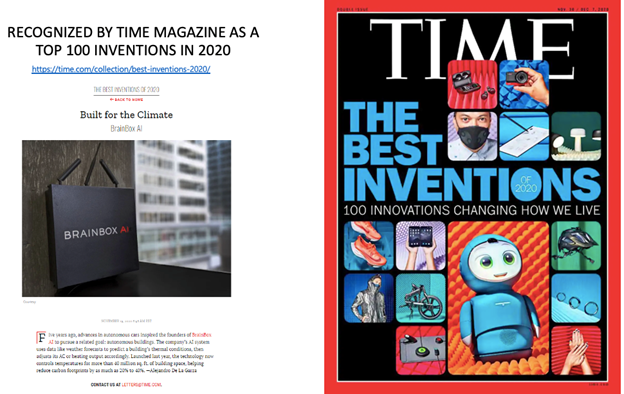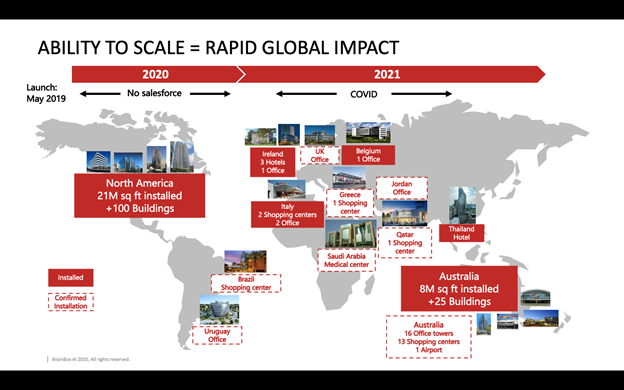

AI Key to Sustainable and Smart Cities, Energy Grid of the Future: Interview with BrainBox AI
Medium Thursday, January 28th 2021We recently spoke with Dynamo’s new cleantech member BrainBox AI to learn more about their innovative solution for the built environment, learn about the role that AI can play in decarbonization, and ask what frontiers they are tackling in 2021. Dynamo Community Director Natalia Sharova interviewed Sam Ramadori, President of BrainBox AI based in Montreal, Canada.
Hi Sam, thank you for finding time in your busy schedule! Let’s dive right in. Could you tell me how does AI work and what role can it play in decarbonization?
There’s a lot of talk about AI given the developments of the last few years and the introduction of exciting new applications. We do see that AI’s potential is sometimes difficult for the outside world to digest, so it is important to provide concrete applications because it is a fairly complex technology. AI can ingest large amounts of different types of data and learn from it quickly. It is particularly good in making accurate predictions based on the data it is learning from, and in optimizing outcomes within complex, multi-variable environments (in our case optimizing HVAC systems in buildings). There are dozens or even hundreds of individual pieces of equipment in a building’s HVAC system with many interdependencies between them, and in this complex environment AI can decide every 5 minutes what the best settings are for each of those components based on its very accurate prediction of the conditions within the space over the next several hours.
Using traditional, rule-based programming, we would simply not be able to operate at that level, so we are fundamentally changing how HVAC systems operate rendering them far more efficient. We recognize that this appears to be a niche application of AI, but when you consider how much energy is consumed in heating and cooling of buildings around the world, you quickly realize how much of an impact we can make on the climate change front by addressing this single issue.
Tell us about BrainBox AI; who you work with and how your solution benefits your customers?
Applying AI’s game-changing capabilities, we aim to cut total energy costs in a building by up to 25%. To achieve this, we optimize the HVAC system by 40–50% as these systems usually account for half of a building’s energy spend. Given the increasing pressures around ESG targets, we work with real estate and facility management firms that own or manage large real estate portfolios. We also seek to work with system integrators that service these firms’ HVAC systems in order to expand our reach across North America and abroad.
One of the key benefits of the technology is scalability because of its light touch implementation in terms of costs and time. The risk/reward balance from a client’s perspective is very attractive given how meaningful the impact is.

Source: BrainBox AI
Tell us about your reach. Where are you operating?
BrainBox AI was launched to market in May 2019 with a handful of buildings, and 20 months later we have a global presence with installations in over 16 countries, across 4 continents. We crossed the one hundred fifty building mark, and we are continuing to grow very rapidly.
Being a Canada-based company, we started installing across the country very quickly. The interesting thing about our growth is that rather than the first international export country being the US, typical for a Canadian company, our first installation abroad was in Australia. That really gave us the confidence to start growing on a global basis. Today, Australia is our second biggest install base of buildings. We are now growing quickly in the US and Europe. Lately, we’ve been expanding in the Middle East and South America. Given the scalability of our technology, whether we install in Toronto or in Bangkok, for us it’s the same thing.
When we talk about the impact on energy consumption on a global basis, the scalability of our technology is key. Our ability to make an impact quickly is significant.

Source: BrainBox AI
What sets you apart from other solutions in this space?
Scalability and impact. We are revolutionizing how commercial HVAC systems operate and through this step change in performance, we are able to improve the energy efficiency of buildings at scale globally. Traditional optimization methods require significant upfront investment and skilled labor that is simply not available at scale. Given the net-zero carbon emission goals we have taken on, the speed of adoption of new technologies, as well as their capital efficiency, are crucial in our ability to meet these climate goals.
What are you most excited for in 2021 and what challenges are you looking to tackle?
Right now, we are adding 1 to 2 new countries to our install base per month and we hope to continue on that global growth path throughout the year.
Our new innovation frontier will look at how we can manage entire portfolios of buildings in a city in order to assist the energy markets as they transition to renewable energy sources.
At this stage we optimize buildings individually but if we are able to manage buildings as a portfolio at the city level, we will be a key contributor in addressing the energy transition challenge.
Whether referred to as smart cities, virtual power plants or distributed renewable energy management, the basic concept revolves around transforming buildings from their status, as individual energy consumers, into inter-connected, grid-interactive prosumers. We believe AI can play a crucial role in this transformation.
What key developments in the clean energy space are you watching in 2021?
Having achieved cost parity or better, the growth in renewable energy capacity is exciting to witness. At the same time, we’re seeing a lot of movement in various related sectors such as grid scale battery storage and smart energy grids. Combine these with electric vehicles, home solar, and battery storage solutions, we will see a wholesale change in how we produce, distribute, and consume energy. 2021 feels like a transformational year in this journey to clean energy. The big challenge as I see it is to find ways to make these disparate systems work together. Having developed autonomous AI that is able to optimize decision-making in a very complex environment, we are excited by the role this technology can play at the energy production and distribution levels.
Visit BrainBox AI website to learn more.
For media relations contact
Claudia Prandoni Marketing & Communications Manager